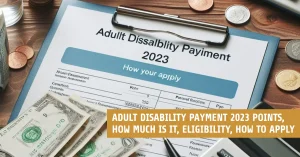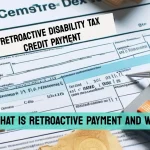For Advertising Contact Us
Retroactive Disability Tax Credit Payment – What is Retroactive Payment and Who gets it?

Over the years, many individuals with disabilities have missed out on valuable financial assistance due to lack of knowledge about retroactive disability tax credit payments. Understanding this crucial aspect of the tax system is imperative for those who qualify for it. Retroactive payment refers to backdated financial support that individuals with disabilities may be eligible to receive. This payment can make a significant difference in their financial situation, providing them with much-needed support. It is important to know who gets access to retroactive disability tax credit payments and how to navigate the process to claim what is rightfully theirs.
Eligibility for Retroactive Disability Tax Credit Payment
Qualifying Factors
Before individuals can receive a retroactive disability tax credit payment, they must meet certain qualifying factors. These factors include having a severe and prolonged physical or mental impairment that significantly restricts their daily activities. Additionally, the individual must have a signed Disability Tax Credit (DTC) certificate by a qualified medical practitioner.
- Severe and prolonged impairment
- Signed Disability Tax Credit certificate
Recognizing qualifying factors is crucial in determining eligibility for a retroactive disability tax credit payment. It is important to understand the specific criteria set out by the Canada Revenue Agency (CRA) to ensure individuals meet the necessary requirements.
Documentation and Evidence Required
Qualifying for a retroactive disability tax credit payment also requires specific documentation and evidence. This includes a detailed application form that outlines the individual’s impairment and its impact on their daily activities. Medical reports and documentation from healthcare professionals are necessary in supporting the application.
Retroactive documentation and evidence play a vital role in the approval process for a retroactive disability tax credit payment. It is crucial for individuals to gather and submit all necessary paperwork to support their claim and increase their chances of a successful application.
Disability tax credit payments can provide much-needed financial support to individuals living with disabilities. By meeting the qualifying factors and providing the required documentation, eligible individuals can receive retroactive payments to help alleviate some of the financial burdens associated with their disabilities.
Types of Retroactive Payments
Some retroactive disability tax credit payments are issued in different ways depending on the circumstances. It is important to understand the types of retroactive payments that individuals may receive:
| Lump-Sum Payments | Yearly Adjustments |
| Lump sum amounts paid in a single payment. | Payments made at regular intervals throughout the year. |
| Can be a significant amount due to backdated payments. | Adjustments are based on changes in the individual’s condition or eligibility. |
| May trigger tax implications depending on the amount received. | Typically reviewed annually to ensure accuracy of benefit amount. |
| Usually paid out in full once approved. | Helps individuals receive the appropriate benefits they are entitled to. |
Lump-Sum Payments
For individuals who have been approved for retroactive disability tax credit payments, they may receive a lump sum payment that covers the total amount owed from the backdated period. This lump sum payment can be a substantial amount, as it includes all the retroactive benefits owed to the individual. It is important for recipients to be aware that receiving a lump sum payment may have tax implications, so it is advisable to consult with a tax professional to understand the impact on their overall tax situation.
Yearly Adjustments
Payments for retroactive disability tax credits can also be made through yearly adjustments to the individual’s benefits. These adjustments are typically done to ensure that the individual is receiving the correct amount of benefits based on their current condition and eligibility status. Yearly adjustments help to keep the benefit amount up to date and accurate, providing individuals with the appropriate financial support they are entitled to receive. This process is imperative in ensuring that individuals are receiving the maximum benefits they are eligible for under the disability tax credit program.
Payments through yearly adjustments are crucial in maintaining the financial stability of individuals with disabilities, as it allows for regular reviews of their benefit amount to reflect any changes in their condition or eligibility. By receiving yearly adjustments, individuals can have peace of mind knowing that they are receiving the correct benefits to support their needs on an ongoing basis.
Step-by-Step Guide to Applying for Retroactive Payment
All information related to applying for retroactive disability tax credit payments will be detailed in this step-by-step guide. Understanding the process thoroughly is crucial to ensure you receive the retroactive payment.
| Preparation Prior to Application | Completing and Submitting Your Application |
Preparation Prior to Application
With any application process, preparation is key. Before you start your application for retroactive disability tax credit payment, gather all necessary documents. This may include medical records, proof of disability, and any relevant financial information. Organizing these documents will streamline the application process and prevent delays.
It is imperative to review the eligibility criteria for retroactive payment to ensure you meet all requirements. Additionally, familiarize yourself with the application form and any specific instructions provided. If you have any questions or need assistance, consider reaching out to a tax professional or disability advocate for guidance.
Completing and Submitting Your Application
Submitting a complete and accurate application is crucial for receiving your retroactive disability tax credit payment. Take your time to fill out the form carefully, providing all necessary information. Double-check your entries to avoid any errors that could delay the processing of your application.
When submitting your application, consider sending it via certified mail or another method that provides proof of delivery. This will help you track your application and ensure it reaches the relevant department safely. Keep a copy of your application and any supporting documents for your records.
Retroactive disability tax credit payments can provide much-needed financial assistance to individuals with disabilities. By following the step-by-step guide outlined above, you can navigate the application process with confidence and increase your chances of receiving the retroactive payment you deserve.
Pros and Cons of Retroactive Disability Tax Credit Payment
Many individuals who receive retroactive disability tax credit payments may wonder about the advantages and drawbacks of this form of payment. It is vital to weigh both the pros and cons to fully understand the implications of retroactive payments.
| Advantages | Drawbacks |
| Provides a lump sum payment which can help cover past expenses or debts. | May impact eligibility for other government benefits based on income level. |
| Offers financial relief and support for individuals who have faced challenges due to disability. | Could result in potential tax implications or changes in tax bracket. |
| Can assist in improving the overall quality of life for the individual and their family. | May require careful financial planning to ensure long-term sustainability. |
| Provides a sense of validation and recognition for the individual’s disability and challenges faced. | Could lead to increased scrutiny or audits from tax authorities. |
Advantages of Receiving Retroactive Payment
Disability retroactive payments can be a lifeline for individuals who have struggled with financial burdens due to their disability. The lump sum payment can offer immediate relief and help cover past expenses, such as medical bills or home modifications. Additionally, receiving retroactive payment acknowledges the challenges and hardships faced by individuals with disabilities, providing a sense of validation and support.
Furthermore, retroactive payments can significantly improve the overall quality of life for the individual and their family. This financial support can help alleviate stress and provide opportunities for better care, education, or living conditions that may not have been possible before.
Possible Drawbacks and Considerations
Any retroactive disability tax credit payment comes with considerations that individuals need to be aware of before accepting the lump sum. One important factor to consider is the potential impact on eligibility for other government benefits. The sudden increase in income from the retroactive payment could affect benefits such as Medicaid or Supplemental Security Income (SSI), leading to a reevaluation of eligibility.
Additionally, individuals need to be cautious about the tax implications of receiving a large lump sum payment. Depending on the amount, it could push them into a higher tax bracket or result in owed taxes. Proper financial planning and consulting with a tax professional are vital to mitigate these potential drawbacks and ensure long-term financial stability.
Another consideration is the possibility of increased scrutiny or audits from tax authorities. The sudden influx of a significant sum may raise red flags and prompt closer examination of the individual’s financial situation. It is important to keep detailed records and be prepared to address any inquiries that may arise.
Tips for Maximizing Your Retroactive Payment
Once again, to ensure you get the most out of your retroactive disability tax credit payment, consider the following tips:
- Keep accurate records of your medical expenses and disability-related costs.
- Seek professional assistance from a tax professional or disability advocate.
- Understand your eligibility for retroactive payments and potential refunds.
After following these tips, you can maximize your retroactive payment and make sure you receive the full benefits you are entitled to.
Keeping Accurate Records
The key to maximizing your retroactive payment is to keep detailed records of all medical expenses and disability-related costs you have incurred. This includes receipts, invoices, and any other documentation that proves your eligibility for the disability tax credit. By maintaining accurate records, you can easily demonstrate the financial impact of your disability and ensure you receive the maximum retroactive payment possible.
Additionally, keeping organized records can help you track your expenses over time and identify any missed deductions or credits that you may be eligible for. This proactive approach can significantly increase your chances of receiving a larger retroactive payment when you file your taxes.
Seeking Professional Assistance
The key to navigating the complexities of the retroactive disability tax credit system is seeking professional assistance. Tax professionals and disability advocates have the knowledge and expertise to help you understand your eligibility for retroactive payments, maximize your benefits, and ensure you are in compliance with all regulations and requirements.
With their assistance, you can avoid costly mistakes and potential audits, while also taking advantage of any available credits or deductions that you may have overlooked. By working with a professional, you can ensure that you receive the full retroactive payment you are entitled to.
To wrap up
With these considerations, it is evident that understanding retroactive disability tax credit payments is crucial for individuals navigating the complexities of tax credits. This payment provides valuable financial support to those who were eligible for the disability tax credit in previous years but did not claim it. By addressing who qualifies for retroactive payments and the process of applying for them, individuals can ensure they receive the benefits they deserve. It is important to stay informed and seek guidance from tax professionals to maximize the potential financial support available through retroactive disability tax credit payments.







